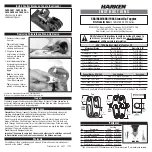
Safety & ESD Precautions
1) Always connect the box to the specified power source: +6.5 to 19.5 V.
2) Keep the internal operating temperature between -20º C and 80º C. (The internal
temperature is displayed in the System menu.) External ambient temperature needs to be
approximately within the range of -40º C and 60º C. Direct exposure to sunlight and an
external cover can also effect internal operating temperature. Though not likely,
overheating of the nanoFlash can potentially damage the unit, and is not covered under the
warrantee. The nanoFlash will attempt to shut itself down if the internal temperature
reaches 95º C.
3)
Avoid operating the unit in an unprotected outdoor installation or wet areas. Do not expose
this product to rain, sand, or snow. Avoid conditions which would cause moisture
condensation on the outside cover, or moisture to get into the internal circuitry. Internal
moisture can also potentially damage the unit, and is not covered under warrantee.
The
nanoFlash is not water proof.
4) Do not drop the unit as this will cause significant damage to several components. Damage
due to dropped units is not covered by the warranty.
5) There are no user serviceable components inside the box. Only a qualified technician
should perform servicing of the unit. Opening the box may void the warranty.
6) Avoid the use of sharp objects near the box as they may scratch the LCD.
7) Clean only with water with a damp cloth.
8) CAUTION: Electrostatic Discharge (ESD) can damage components in this product.
Although the unit has countermeasures to this hazard installed inside, it is always best to
avoid damage by using extra caution when handling and inserting Compact Flash cards or
the LCD screen and connectors. Always ground yourself (by touching an un-painted
grounded metal object) prior to handling the unit.
9) Do not touch exposed connector pins and do not insert any metal objects in the connectors.
10)Ensure that all connections made to the box (including at the “other end of the cable”) are
made in ESD safe environments.
11)Always transport and store the box in the static protected bag included with the nanoFlash
12)Use caution when connecting the 4-pin Hirose power and 6-pin Hirose Remote/LTC ports,
as the pin-outs for these types of connectors is not always standard across all toolsets. The
pin-out that the nanoFlash uses is detailed on page 27, use this as a guide to ensure that
proper connections are being made and damage is not done to your unit as a result of
improper connections.
nanoFlash
28








































